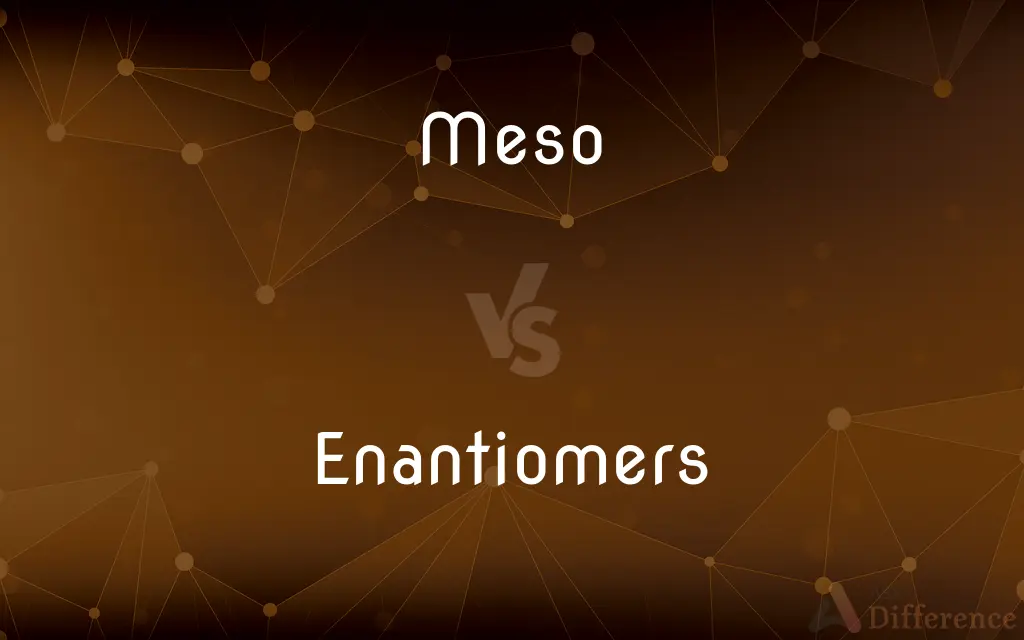Meso vs. Enantiomers — What's the Difference?
Edited by Tayyaba Rehman — By Fiza Rafique — Published on December 16, 2023
Meso compounds are molecules with chiral centers but are overall achiral due to a plane of symmetry; Enantiomers are non-superimposable mirror images of chiral molecules.

Difference Between Meso and Enantiomers
Table of Contents
ADVERTISEMENT
Key Differences
Meso compounds and Enantiomers both deal with the concept of chirality in organic chemistry. Meso compounds possess multiple chiral centers, yet, intriguingly, they don't exhibit optical activity. This is because they have an internal plane of symmetry, making one half of the molecule a mirror image of the other, canceling out any optical activity.
On the flip side, Enantiomers are a pair of molecules that are mirror images of each other, much like left and right hands. They cannot be superimposed on one another. Enantiomers exhibit opposite optical activities, meaning that they rotate plane-polarized light in opposite directions, making them of great significance in fields like pharmaceuticals, where one Enantiomer can be therapeutic and the other potentially harmful.
The distinction between Meso compounds and Enantiomers is vital in stereochemistry. While Meso compounds have chiral centers, their overall molecule is achiral. Enantiomers, however, are entirely chiral and have no plane of symmetry, leading to their distinct optical properties.
Meso compounds, despite having chiral centers, will not rotate plane-polarized light, thanks to their symmetry. Enantiomers, due to their unique structures, will rotate this light, and when a racemic mixture (a 1:1 mixture of both Enantiomers) is present, the rotations cancel out, resulting in no observed optical activity.
In summary, while both Meso compounds and Enantiomers relate to molecular symmetry and chirality, they represent different aspects. Meso deals with internal symmetry in a single molecule, while Enantiomers concern the relationship between two chiral molecules that are mirror images.
ADVERTISEMENT
Comparison Chart
Definition
Achiral molecule with chiral centers
Non-superimposable mirror images
Optical Activity
None due to internal symmetry
Opposite for each Enantiomer
Presence of Plane of Symmetry
Yes
No
Relationship
Refers to a single molecule
Refers to a pair of molecules
Pharmaceutical Importance
Less direct relevance
Critical, as different Enantiomers can have different effects
Compare with Definitions
Meso
A unique type of stereoisomer with balanced chiral centers.
The balanced nature of Meso compounds means they don't rotate light as other chiral molecules do.
Enantiomers
Non-superimposable mirror image molecules.
The Enantiomers of a molecule rotate plane-polarized light in opposite directions.
Meso
A molecule with chiral centers but overall achiral due to symmetry.
Despite its chiral centers, tartaric acid has a Meso form that doesn't exhibit optical activity.
Enantiomers
Pairs of molecules with opposite optical activities.
Some drugs have Enantiomers where only one form is therapeutically active.
Meso
Stereoisomers with an internal plane of symmetry.
The Meso form of some compounds can be identified by its lack of rotation of plane-polarized light.
Enantiomers
Chiral molecules that are mirror images.
One of the key topics in organic chemistry is distinguishing between Enantiomers.
Meso
Molecules that have mirror-image halves.
A Meso compound, when split down its plane of symmetry, yields two mirror-image halves.
Enantiomers
Stereoisomers that cannot be superimposed.
Enantiomers play a vital role in the pharmaceutical industry due to their unique properties.
Meso
Compounds with multiple chiral centers but are optically inactive.
Some Meso compounds surprise students when they don't behave as typical chiral molecules.
Enantiomers
Molecules with the same formula but different spatial orientations.
The discovery of Enantiomers has significant implications for the field of drug design.
Enantiomers
Either of a pair of molecules that are mirror images but cannot be superimposed on each other, and that rotate the plane of polarized light by an equal amount in opposite directions. Also called enantiomorph, optical isomer.
Enantiomers
Plural of enantiomer
Common Curiosities
Do Meso compounds have chiral centers?
Yes, Meso compounds have chiral centers, but their overall molecule is achiral.
Why are Enantiomers significant in drug design?
Different Enantiomers can have different biological effects, making one therapeutic and the other potentially harmful.
Can a molecule with a single chiral center be Meso?
No, a molecule with only one chiral center cannot be Meso.
Do Meso compounds exhibit optical activity?
No, Meso compounds do not exhibit optical activity due to their internal plane of symmetry.
How do Enantiomers affect plane-polarized light?
Enantiomers rotate plane-polarized light in opposite directions.
What are Meso compounds?
Meso compounds are molecules with chiral centers but are overall achiral due to a plane of symmetry.
How can you differentiate between Enantiomers?
Enantiomers can be differentiated using optical rotation or by using chiral chromatography.
Why is it challenging to separate Enantiomers?
Because Enantiomers have nearly identical physical and chemical properties, making their separation tricky.
How do Enantiomers differ?
Enantiomers are non-superimposable mirror images of chiral molecules.
Are Meso compounds common?
Meso compounds are less common than typical chiral compounds but are important in stereochemistry.
Can a racemic mixture have optical activity?
No, a racemic mixture, which is a 1:1 mixture of Enantiomers, has no optical activity as the effects cancel out.
Do Enantiomers have the same physical properties?
Enantiomers have identical physical properties except for their optical rotation.
Are all molecules with chiral centers optically active?
No, Meso compounds have chiral centers but are optically inactive.
Share Your Discovery

Previous Comparison
Saturated Hydrocarbons vs. Unsaturated Hydrocarbons
Next Comparison
Strong Electrolytes vs. Weak ElectrolytesAuthor Spotlight
Written by
Fiza RafiqueFiza Rafique is a skilled content writer at AskDifference.com, where she meticulously refines and enhances written pieces. Drawing from her vast editorial expertise, Fiza ensures clarity, accuracy, and precision in every article. Passionate about language, she continually seeks to elevate the quality of content for readers worldwide.
Edited by
Tayyaba RehmanTayyaba Rehman is a distinguished writer, currently serving as a primary contributor to askdifference.com. As a researcher in semantics and etymology, Tayyaba's passion for the complexity of languages and their distinctions has found a perfect home on the platform. Tayyaba delves into the intricacies of language, distinguishing between commonly confused words and phrases, thereby providing clarity for readers worldwide.












































